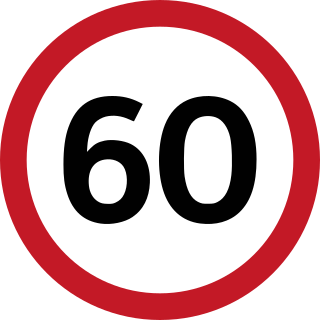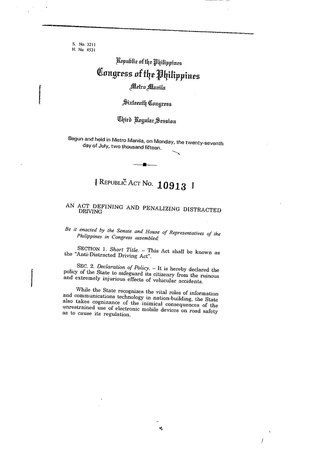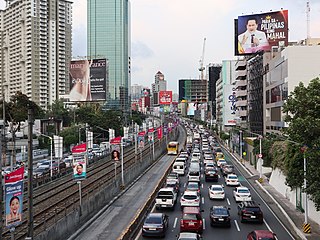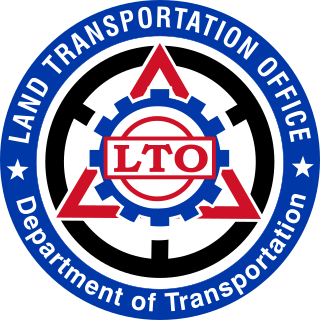
A department of motor vehicles (DMV) is a government agency that administers motor vehicle registration and driver licensing. In countries with federal states such as in North America, these agencies are generally administered by subnational entities governments, while in unitary states such as many of those in Europe, DMVs are organized nationally by the central government.

The Pennsylvania Department of Transportation (PennDOT) oversees transportation issues in the Commonwealth of Pennsylvania. The administrator of PennDOT is the Pennsylvania Secretary of Transportation, Michael B. Carroll. PennDOT supports nearly 40,000 miles (64,000 km) of state roads and highways, about 25,000 bridges, and new roadway construction with the exception of the Pennsylvania Turnpike Commission.

The Ministry of Transportation (MTO) is the provincial ministry of the Government of Ontario that is responsible for transport infrastructure and related law in Ontario, Canada. The ministry traces its roots back over a century to the 1890s, when the province began training Provincial Road Building Instructors. In 1916, the Department of Public Highways of Ontario (DPHO) was formed and tasked with establishing a network of provincial highways. The first was designated in 1918, and by the summer of 1925, sixteen highways were numbered. In the mid-1920s, a new Department of Northern Development (DND) was created to manage infrastructure improvements in northern Ontario; it merged with the Department of Highways of Ontario (DHO) on April 1, 1937. In 1971, the Department of Highways took on responsibility for Communications and in 1972 was reorganized as the Ministry of Transportation and Communications (MTC), which then became the Ministry of Transportation in 1987.

Vehicle license plates in the Philippines are issued and regulated by the Land Transportation Office, a government agency under the Department of Transportation (DOTr).

The Department of Transportation is the executive department of the Philippine government responsible for the maintenance and expansion of viable, efficient, and dependable transportation systems as effective instruments for national recovery and economic progress. It is responsible for the country's land, air, and sea communications infrastructure.

The New Jersey Motor Vehicle Commission is a governmental agency of the U.S. state of New Jersey. The equivalent of the Department of Motor Vehicles in other states, it is responsible for titling, registering and inspecting automobiles, and issuing driver's licenses.

The Land Transportation Franchising and Regulatory Board is an agency of the Republic of the Philippines under the Department of Transportation (DOTr). The LTFRB was established on June 19, 1987, during the former president Corazon Aquino’s administration.

The Regional Transport Office or District Transport Office or Regional Transport Authority (RTO/DTO/RTA) is an office administered by the State Governments constituted under Section 213 (1) of the Motor Vehicles Act, 1988 of India and is responsible for implementing the various provisions of this Act. It operates under the Transport Department of the State Government. It is responsible for maintaining a database of drivers and a database of vehicles for various states of India.
A driving licence is a document that allows the holder to drive on any roads in the Republic of China. It is issued by the Ministry of Transportation and Communications to a qualified motor vehicle driver. The number on a license is the same as the ID number of the license holder's household registration in Taiwan. In Taiwan, the license is sometimes accepted as a valid identity document, as its information replicates most of what is on a National Identification Card.
Driver's license in the Philippines consists of three types. These are student permit, non-professional, and professional. The minimum age for driving in the Philippines is 16 years old, provided that the driver has applied for a student permit and is accompanied by a duly licensed person, whether professional or non-professional. An applicant can only apply for a non-professional driver's license one month after acquiring a student permit. An applicant needs to have a non-professional driver's license for six months to be eligible for a professional driver's license. An applicant must pass both the Land Transportation Office written exam and a driving exam. If the applicant fails the tests, the applicant must wait for a month before being able to take the tests again.

Taxicabs of the Philippines are one of the modes of transportation in the country. They are regulated by the Department of Transportation (DOTr), the Land Transportation Office (LTO), and the Land Transportation Franchising and Regulatory Board (LTFRB). The taxicabs there vary from models and uses. Most taxicabs have yellow colored license plates, taxi signs, LTFRB Registration number, and taximeter, which is mandatory in every cab.

Speed limits in the Philippines are specified in Republic Act No. 4136, or the Land Transportation and Traffic Code of the Philippines, which took effect on its approval on June 20, 1964. The act covers a number of areas other areas than speed limits, and was amended regarding some of those areas by Republic Act No. 10930, which was approved on August 2, 2017.

A driver's license, driving licence, or driving permit is a legal authorization, or the official document confirming such an authorization, for a specific individual to operate one or more types of motorized vehicles—such as motorcycles, cars, trucks, or buses—on a public road. Such licenses are often plastic and the size of a credit card.

The Anti-Distracted Driving Act (ADDA), officially designated as Republic Act No. 10913, is a Philippine law that prohibits distracted driving by restricting and penalizing the use of mobile phones and other electronics devices while driving on any public thoroughfare, highway, or street in the Philippines. The republic act defines "distracted driving" as "using mobile communications device to write, send, or read a text-based communication or to make or receive calls" or "using an electronic entertainment or computing device to play games, watch movies, surf the internet, compose messages, read e-books, perform calculations, and other similar acts" while behind the wheel of a moving vehicle or while temporarily stopped at a red light. The law covers all private and public vehicles, including agricultural machines, construction equipment, public utility buses and jeepneys, taxicabs, motorcycles, tricycles, pedicabs, kuligligs and carriages.

According to a "Global Driver Satisfaction" survey conducted by the navigation app Waze in 2015, Metro Manila had the "worst traffic on Southeast Asia". Emerson Carlos, MMDA assistant general manager for operation has mentioned that in 2015, motor vehicle registrations in Metro Manila peaked at around 2.5 million.

The Public Utility Vehicle Modernization Program (PUVMP) is a program made by the Department of Transportation of the Philippines in 2017, with the goal of making the country's public transportation system efficient and environmentally friendly by 2020. The program calls for the phasing-out of jeepneys, buses and other Public Utility Vehicles (PUVs) that are at least 15 years old and replacing them with safer, more comfortable and more environmentally-friendly alternatives over the next three years. Currently, there are 220,000 jeepney units operating throughout the country.
DBDOYC Inc., doing business as Angkas, is a Philippine motorcycle vehicle for hire and package delivery company based in Makati, Metro Manila.

Cycling is a popular mode of transport and recreational sport in the Philippines.

On the late afternoon of August 8, 2023, a road rage incident occurred when former Philippine National Police (PNP) officer Wilfredo Gonzales, driving a red Kia Rio, cut off Allan Bandiola, who was riding his bicycle in the bicycle lane near Welcome Rotonda in Doña Josefa, Quezon City, the Philippines. Following the altercation, Gonzales exited his car, threatened to shoot the cyclist with a handgun, and slapped him on the head. On the same day, a settlement was reached between both parties, with Bandiola paying ₱500 to Gonzales for damages to his car.

Traffic law in the Philippines consists of multiple laws that govern the regulation and management of road transportation and the conduct of road users within the country.





















